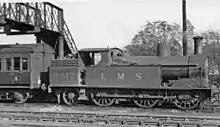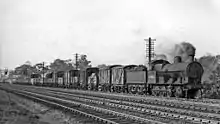Leighton Buzzard railway station
Leighton Buzzard railway station serves the towns of Leighton Buzzard and Linslade in the county of Bedfordshire and nearby areas of Buckinghamshire. Actually situated in Linslade, the station is 40 miles (64 km) north west of London Euston and is served by London Northwestern Railway services on the West Coast Main Line. Until the 1960s the station was the start of a branch to Dunstable and Luton, with a junction just north of the present station. The station has four platforms. Platforms 1 & 2 serve the fast lines and are used by Avanti West Coast services running non-stop to/from London Euston. Platforms 3 & 4 are served by slower London Northwestern railway services to/from London Euston.
Leighton Buzzard | |
|---|---|
 | |
| General information | |
| Location | Linslade, Central Bedfordshire England |
| Grid reference | SP910250 |
| Managed by | London Northwestern Railway |
| Platforms | 4 |
| Other information | |
| Station code | LBZ |
| Classification | DfT category C2 |
| History | |
| Original company | London and Birmingham Railway |
| Key dates | |
| 9 April 1838 | Opened as Leighton |
| 14 February 1859 | Rebuilt 160m to the south |
| 1 July 1911 | Renamed Leighton Buzzard |
| 6 February 1967 | Goods services withdrawn |
| September 1989 | Rebuilt |
| Passengers | |
| 2017/18 | |
| 2018/19 | |
| 2019/20 | |
| 2020/21 | |
| 2021/22 | |
| Location | |
| Notes | |
Passenger statistics from the Office of Rail and Road | |

Page's Park railway station, terminus for the Leighton Buzzard Light Railway (a narrow gauge heritage railway), is on the opposite side of the town.
History
The first station simply known as Leighton was opened by the London and Birmingham Railway on 9 April 1838[1] as part of the first section of its line from London Euston to Denbigh Hall.[2] The line had originally been planned to pass through Buckingham but opposition from the Duke of Buckingham ensured that it forced east through Linslade.[3] A station with two-facing platforms was opened a ¼-mile south of the Linslade tunnels. These are arranged unusually for a four track main line: the southbound slow line has a tunnel to itself as does the northbound fast line, however the northbound slow and southbound fast lines share a tunnel. This stems from the fact that the line was built as double-track and when quadrupled, the two extra lines could only be placed along both sides, as single-track tunnels.
In May 1848, the station became a junction when a branch line to Dunstable was opened.[4] The London and North Western Railway replaced the first station in February 1859 by another more permanent structure located 8 chains (160 m) to the south.[5] The new building had an imposing frontage featuring arched windows.[3] Access to the Dunstable branch was controlled by Leighton No. 2 signal box situated to the north of the station, while the actual branch signals were controlled by the main line box to the south.[6] In 1874, land was purchased to the south of the station alongside the Dunstable branch for the construction of goods sidings, which eventually became known as Wing Yard.[7]
The LNWR was absorbed by the London, Midland and Scottish Railway in the 1923 railway grouping and, in 1927, it added a crossover between the fast and slow lines. This was to play a significant role in the derailment of Royal Scot No. 6114 "Coldstream Guardsman" at Linslade on 22 March 1931 when the driver took the crossover at 50–60 mph instead of the regulation 15 mph. There had been a diversion in place on the fast lines and the driver had missed the warning signals.[8] The engine overturned and six people were killed, including the driver and fireman.[9] The Scotland amateur football team was on the train, but remained unscathed.[10]
In 1957–1958 the platform buildings were rebuilt and a concrete awning placed over the platform. At the entrance a larger booking / waiting hall, central heating, electric lighting and the cycle storage, parcels and loading bay were improved.[11]
The Great Train Robbery of 1963 occurred just south of this station, at Bridego Bridge near Ledburn, at a bridge on the southbound stretch towards Cheddington.[12] Wing Yard was closed in February 1967[13] and it is now used as a car park,[14] while the branch to Dunstable was closed from June.[7] In 1989, the platforms were lengthened to accommodate 12-coach trains and a £1.8m project to rebuild the station was started.[7]

Motive power depot
The London and North Western Railway opened a small motive power depot at the south end of the station in 1859. This was reroofed in 1957 but closed 5 November 1962 and was demolished.[15]
Services
Current services
All services at Leighton Buzzard are operated by London Northwestern Railway.
The typical off-peak service in trains per hour is:[16]
- 4 tph to London Euston (2 of these are stopping services, 1 calls at Watford Junction only and 1 runs non-stop)
- 2 tph to Milton Keynes Central
- 2 tph to Birmingham New Street via Northampton
During the peak hours, the station is served by a number of additional services between London Euston and Bletchley.
Connex South Central
In June 1997, Connex South Central began operating services between Gatwick Airport and Rugby via the Brighton and West London Lines that called at Leighton Buzzard with Class 319s.[17][18] It was cut back to terminate at Milton Keynes in December 2000 before being withdrawn in May 2002 due to capacity constraints on the West Coast Main Line while the latter was being upgraded.
Southern
Southern reintroduced the service in February 2009 with Class 377s operating initially operating from Brighton to Milton Keynes before being curtailed at its southern end at South Croydon and later Clapham Junction.[19][20] In May 2022, Southern cut the service back to terminate at Watford Junction,[21] where passengers for Leighton Buzzard may transfer to a London Northwestern service.
| Preceding station | Following station | |||
|---|---|---|---|---|
| Bletchley | London Northwestern Railway |
Cheddington or Watford Junction or London Euston | ||
| Previous services | ||||
| Southern | ||||
| Disused railways | ||||
| Terminus | London and North Western Railway | Line and station closed |
||
Interchange
Leighton Buzzard station is served by several local buses. The F70 bus route, operated by Arriva Shires & Essex, provides a direct Bus rapid transit service to Luton via the Luton to Dunstable Busway, with an onward connection to Luton Airport and also to Milton Keynes.[22] The F77 bus route, also operated by Arriva, provides the same service to Luton and also a service to Bletchley.[23][24][25]
Reinstating the connection to Luton
There have been past proposals about reopening the former line to Dunstable as either a rail link or as a guided busway,[26] before little of its route had been lost to new construction, Although there is now a guided busway between Dunstable and Luton, much of the Leighton Buzzard to Dunstable section was lost to the Leighton Buzzard Southern Bypass road.
Accidents and incidents
On 22 March 1931, a passenger train was derailed due to excessive speed through a crossover. Six people were killed.[27]
References
- Butt 1995, p. 141.
- Leleux 1984, p. 19.
- Simpson 1998, p. 7.
- Oppitz 2000, p. 100.
- Woodward & Woodward 2008, fig. 2.
- Woodward & Woodward 2008, fig. 4.
- Simpson 1998, p. 83.
- Leleux 1984, p. 240.
- Simpson 1998, p. 36.
- "A Celebration – 100 Years of the SAFA" (PDF). p. 17. Retrieved 24 October 2017.
- The Railway Magazine. December 1957. p. 883.
{{cite magazine}}: Missing or empty|title=(help) - Oppitz 2000, pp. 99–100.
- Clinker 1978, p. 75.
- Shannon 1995, p. 70.
- Roger Griffiths and Paul Smith, The directory of British engine sheds:1 (Oxford Publishing Co., 1999), p.119. ISBN 0 86093 542 6.
- Table 66 National Rail timetable, December 2022
- "South Central to launch Rugby-Gatwick service". Rail Magazine. No. 305. 21 May 1997. p. 10.
- "Connex Makes a Rugby Connection". Rail Express. No. 15. August 1997. p. 7.
- New Timetable means more more services to and from Euston Network Rail 14 December 2008
- "Southern extends to Milton Keynes". The Railway Magazine. No. 1296. April 2009. p. 10.
- Changes to National Rail Timetable National Rail 15 May 2022
- "F70 Timetable". bustimes. Retrieved 8 November 2020.
- "F77 Timetable". bustimes. Retrieved 8 November 2020.
- "Routes & Timetables". Busway. Luton Borough Council. Retrieved 7 July 2017.
- "Bus timetables and bus routes". centralbedfordshire.gov.uk. Central Bedfordshire Council. Retrieved 7 July 2017.
- "Report calls for busway extension to Leighton Buzzard and Cheddington". Leighton Buzzard Observer. 27 March 2018. Retrieved 1 April 2020.
- Hall 1990, p. 97.
Sources
- Butt, R. V. J. (October 1995). The Directory of Railway Stations: details every public and private passenger station, halt, platform and stopping place, past and present (1st ed.). Sparkford: Patrick Stephens Ltd. ISBN 978-1-85260-508-7. OCLC 60251199. OL 11956311M.
- Clinker, C.R. (October 1978). Clinker's Register of Closed Passenger Stations and Goods Depots in England, Scotland and Wales 1830–1977. Bristol: Avon-Anglia Publications & Services. ISBN 0-905466-19-5.
- Hall, Stanley (1990). The Railway Detectives. London: Ian Allan. ISBN 0-7110-1929-0.
- Leleux, Robin (1984) [1976]. A Regional History of the Railways of Great Britain: The East Midlands (Volume 9). Newton Abbot, Devon: David St. John Thomas. ISBN 978-0-946537-06-8.
- Oppitz, Leslie (2000). Lost Railways of the Chilterns (Lost Railways Series). Newbury, Berkshire: Countryside Books. ISBN 978-1-85306-643-6.
- Shannon, Paul (1995). British Railways Past and Present: Buckinghamshire, Bedfordshire and West Hertfordshire (No. 24). Wadenhoe, Peterborough: Past & Present Publishing Ltd. ISBN 978-1-85895-073-0.
- Simpson, Bill (1998). The Dunstable Branch. Witney, Oxon: Lamplight Publications. ISBN 978-1-899246-03-8.
- Woodward, Sue; Woodward, Geoff (May 2008). Branch Line to Dunstable from Leighton Buzzard to Hatfield. Midhurst, West Sussex: Middleton Press. ISBN 978-1-906008-27-7.
External links
- Train times and station information for Leighton Buzzard railway station from National Rail